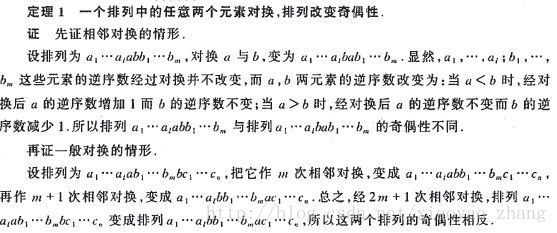8数码 HDU-Eight (A*算法+bfs+康托展开+优先队列)
Eight
Time Limit: 10000/5000 MS (Java/Others) Memory Limit: 65536/32768 K (Java/Others)Total Submission(s): 28098 Accepted Submission(s): 7473
Special Judge
Problem Description
The 15-puzzle has been around for over 100 years; even if you don't know it by that name, you've seen it. It is constructed with 15 sliding tiles, each with a number from 1 to 15 on it, and all packed into a 4 by 4 frame with one tile missing. Let's call the missing tile 'x'; the object of the puzzle is to arrange the tiles so that they are ordered as:
where the only legal operation is to exchange 'x' with one of the tiles with which it shares an edge. As an example, the following sequence of moves solves a slightly scrambled puzzle:
The letters in the previous row indicate which neighbor of the 'x' tile is swapped with the 'x' tile at each step; legal values are 'r','l','u' and 'd', for right, left, up, and down, respectively.
Not all puzzles can be solved; in 1870, a man named Sam Loyd was famous for distributing an unsolvable version of the puzzle, and
frustrating many people. In fact, all you have to do to make a regular puzzle into an unsolvable one is to swap two tiles (not counting the missing 'x' tile, of course).
In this problem, you will write a program for solving the less well-known 8-puzzle, composed of tiles on a three by three
arrangement.
1 2 3 4 5 6 7 8 9 10 11 12 13 14 15 x
where the only legal operation is to exchange 'x' with one of the tiles with which it shares an edge. As an example, the following sequence of moves solves a slightly scrambled puzzle:
1 2 3 4 1 2 3 4 1 2 3 4 1 2 3 4
5 6 7 8 5 6 7 8 5 6 7 8 5 6 7 8
9 x 10 12 9 10 x 12 9 10 11 12 9 10 11 12
13 14 11 15 13 14 11 15 13 14 x 15 13 14 15 x
r-> d-> r->
The letters in the previous row indicate which neighbor of the 'x' tile is swapped with the 'x' tile at each step; legal values are 'r','l','u' and 'd', for right, left, up, and down, respectively.
Not all puzzles can be solved; in 1870, a man named Sam Loyd was famous for distributing an unsolvable version of the puzzle, and
frustrating many people. In fact, all you have to do to make a regular puzzle into an unsolvable one is to swap two tiles (not counting the missing 'x' tile, of course).
In this problem, you will write a program for solving the less well-known 8-puzzle, composed of tiles on a three by three
arrangement.
Input
You will receive, several descriptions of configuration of the 8 puzzle. One description is just a list of the tiles in their initial positions, with the rows listed from top to bottom, and the tiles listed from left to right within a row, where the tiles are represented by numbers 1 to 8, plus 'x'. For example, this puzzle
1 2 3
x 4 6
7 5 8
is described by this list:
1 2 3 x 4 6 7 5 8
1 2 3
x 4 6
7 5 8
is described by this list:
1 2 3 x 4 6 7 5 8
Output
You will print to standard output either the word ``unsolvable'', if the puzzle has no solution, or a string consisting entirely of the letters 'r', 'l', 'u' and 'd' that describes a series of moves that produce a solution. The string should include no spaces and start at the beginning of the line. Do not print a blank line between cases.
Sample Input
2 3 4 1 5 x 7 6 8
Sample Output
ullddrurdllurdruldr
A*算法:这儿讲得很好
http://sh.qihoo.com/pc/detail?url=http%3A%2F%2Fzm.news.so.com%2F801d781eb0f8c3ec1170adc50328bb9c&check=74da52006d1963b8&sign=baike
康托展开: http://blog.csdn.net/axiqia/article/details/51346404
定理:一个排列中的任意两个元素对换,排列改变逆序数的奇偶性
在与空白交换过程中,数码的逆序数不变。
左右交换,逆序数不变;上下交换,某个数字移动两位,逆序数不变。
#include
#include
#include
#include
#include
using namespace std;
struct Node
{
int mp[3][3];
int x,y;
int h,g;//h:距目标还有多远 g:走了多少步
int hash;//此时数码序列在整个全排列中的次序,即hash值
bool operator < (const Node A)const//优先队列的比较方式 重载 <
{
if(A.h!=h) return A.h=0&&x<3&&y>=0&&y<3)
return true;
return false;
}
}u,v;
int vis[400000];//记录交换方式
int pre[400000];//记录前一个数码序列的hash值
int dir[4][2]={0,1,0,-1,1,0,-1,0};
int Hash[]={1,1,2,6,24,120,720,5040,40320,362880};
int get_hash(Node temp)//康托展开,计算数列的hash值
{
int a[9],k=0,count=0;
for(int i=0;i<3;i++)
for(int j=0;j<3;j++)
a[k++]=temp.mp[i][j];
for(int i=0;i<9;i++)
{
int sum=0;
for(int j=i+1;j<9;j++)
if(a[i]>a[j]) sum++;
count+=sum*Hash[9-i-1];
}
return count+1;
}
int get_h(Node temp)//估价函数 ,每个数字到目标位置的距离,曼哈顿距离
{
int count=0;
for(int i=0;i<3;i++)
for(int j=0;j<3;j++)
if(temp.mp[i][j])
count+=abs(i-(temp.mp[i][j]-1)/3)+abs(j-(temp.mp[i][j]-1)%3);
return count;
}
bool judge(Node temp)//判断是否有解
{
int a[9],k=0,count=0;
for(int i=0;i<3;i++)
for(int j=0;j<3;j++)
a[k++]=temp.mp[i][j];
for(int i=0;i<9;i++)
for(int j=i+1;j<9;j++)
if(a[i]&&a[j]&&a[i]>a[j])
count++;
return count&1;
}
void print()
{
string str;
str.clear();
int start=46234;
while(pre[start]!=-1)
{
if(vis[start]==0) str+='r';
else if(vis[start]==1) str+='l';
else if(vis[start]==2) str+='d';
else if(vis[start]==3) str+='u';
start=pre[start];
}
for(int i=str.size()-1;i>=0;i--)
cout< q;
q.push(u);
vis[u.hash]=-2;
while(!q.empty())
{
u=q.top();
q.pop();
for(int i=0;i<4;i++)
{
v=u;
v.x+=dir[i][0];
v.y+=dir[i][1];
if(v.check())
{
swap(v.mp[v.x][v.y],v.mp[u.x][u.y]);
v.hash=get_hash(v);
if(vis[v.hash]==-1)
{
v.h=get_h(v);
v.g++;
vis[v.hash]=i;
pre[v.hash]=u.hash;
q.push(v);
}
}
if(v.hash==46234)
{print();return ;}
}
}
}
int main()
{
char ch[50];
while(cin>>ch[0])
{
for(int i=1;i<9;i++)
cin>>ch[i];
for(int i=0;i<3;i++)
for(int j=0;j<3;j++)
if(ch[i*3+j]=='x')
{u.mp[i][j]=0,u.x=i,u.y=j;u.g=0;}
else
u.mp[i][j]=ch[i*3+j]-'0';
u.h=get_h(u),u.hash=get_hash(u);
if(u.hash==46234)
{cout< 